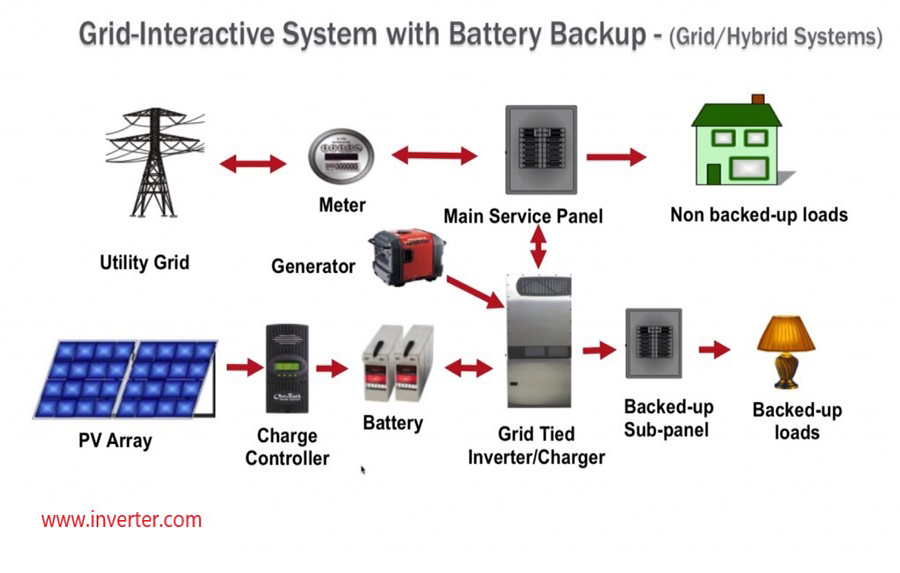In the market there are 3 different solar photovoltaic systems; on grid system, on grid with battery backup (hybrid) and completely off grid system; Let us describe each individually:
First: On Grid Photovoltaic system
That is the common setup system, its connected to the power grid, the electricity generated from solar will be first used to run your loads "equipment/appliances", and if there will be surplus electricity generation, it will exported to the power grid, and your power retailer will pay you for it (approx. 6-30 cent per kwh), and if the solar generation is not sufficient or not operating (night), electricity will be imported automatically from your retailer and you will pay for it at the end of the month.
 The main component of on grid system is the inverter which converts solar panels generated dc electricity to ac electricity and synchronize it with the gird, of course the ac voltage and frequency must be the same as the grid in order to fulfill that synchronization, so the inverter is constantly monitor the grid and measure voltage and frequency, also the inverter disconnects in case of grid shutdown for safety (Islanding). Choosing the high-quality solar inverter is very important, because low quality inverter will suffer and trip out if your grid voltage varies, so the solar photovoltaic system will temporarily shut down and can not cope with our grid voltage fluctuations, resulted in disconnection for long periods and lose us much solar output power.
The main component of on grid system is the inverter which converts solar panels generated dc electricity to ac electricity and synchronize it with the gird, of course the ac voltage and frequency must be the same as the grid in order to fulfill that synchronization, so the inverter is constantly monitor the grid and measure voltage and frequency, also the inverter disconnects in case of grid shutdown for safety (Islanding). Choosing the high-quality solar inverter is very important, because low quality inverter will suffer and trip out if your grid voltage varies, so the solar photovoltaic system will temporarily shut down and can not cope with our grid voltage fluctuations, resulted in disconnection for long periods and lose us much solar output power.
The only disadvantage of this system is that incase of grid shut down, it will disconnect, and our home appliances will not work.
Second: On Grid with battery backup (hybrid) Photovoltaic system
This system consists of regular on grid solar system plus sophisticated control equipment plus batteries. So it stores excess electricity generated from solar panels power inverter on the day time (inside batteries) to be used at the night. Suppose that your load demand is 4kw and solar electricity generated is 3kw, in that case, the batteries will jump in and supply the 1kw shortage, also you can adjust time of use to offset the expensive peak power period.
Generally, in hybrid system, the batteries capacity will not be large, so it’s not sufficient to run the whole system in case of grid shutdown, but it will be able to run certain appliances with dedicated "separate"circuits after disconnecting the home from the grid, so you should specify these certain appliances like important medical equipment or fridge, etc. to your solar system designer at design stage.
The hybrid inverter and control system usually not used in high demand homes over 5kw capacity.
Third: Off Grid Photovoltaic system
This system is used in remote areas in where utility power doesn’t exist, like remote farms, telecommunications sites, water pumping systems, etc. We need to make accurate energy audit and site assessments to our site before installing this system to make good matching between solar generation and the demand.
Although batteries are considered as a main part in that system, and we can totally depend on it, this system often includes backup generator to be used in low solar irradiance days and high power demands.
Using such system is a reliable and much cost effective alternative to the diesel generators usage in remote areas (No fuel, no maintenance, and virtually silent).
